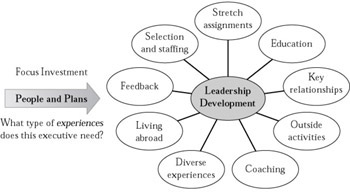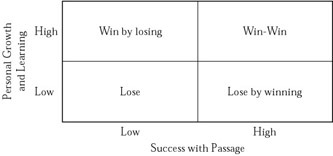How Organizations Can Facilitate Learning
How can organizations facilitate leadership learning and growth in the passages? In the sections that follow, we offer four suggestions.
In one sense, I don’t know where all my own personal motivation and focus comes from. In another sense, I think I got a lot of it from watching my father go through his life and the extent to which he identified and lived his personal value system. I applied his example to situations, for me as a leader, even before Pacific Gas and Electric company filed for Chapter 11 protection. I knew that moving in and out of bankruptcy was going to require focus on some very simple facts and objectives that we couldn’t get away from. My dad’s example, even now, with his not being well, has given me a huge amount of strength. I tell the members of my team that every bad day I have here is better than a good day for him right now. The lesson to me was that you can get through all of the things in your life, including your own personal declining health and frailty, by having a sense of mission, purpose, and values. That’s what I drew from the way my dad lives his life. That makes it very easy to deal with things that are very tough. I don’t ever remember consciously adopting that. I’ve said to many folks that his life’s experience has had an impact on me and has helped me to have a values arrow kind of built in.
Bob Glynn, chairman, CEO, and president, PG&E Corporation
Expand the View of Potential Leaders
Those in charge of core people processes must assess and develop the whole person. This means hiring individuals who have more than the right education, background, or core competencies. Hiring decisions should also factor in the diversity and adversity each candidate has experienced, along with exploring how or whether they have helped him change and grow. Someone who has worked at Dell or Microsoft might very well make an excellent leader, but so would someone who has worked in Africa, volunteered in the inner city, or run a political campaign. Truly astute leaders have already figured this out. As one CEO remarked to us, “If I want to find a global leader, I look for the kid who backpacked around Europe in his twenties, not necessarily the one who went from his B.A. to an internship at IBM.” Similarly, a stronger candidate may not have a string of successes on his résumé, but he may have been through an acquisition, divestiture, late-career change of direction, or even significant failure. (As an example, many smart companies we know recently moved quickly to pick up former Arthur Andersen partners and principals, with the correct view that the implosion of that firm produced even smarter professionals.)
A broader understanding and view of experience will lead companies to ask different questions during the core processes of succession and planning. The goal will be to determine what passages people have been through and what they’ve learned from these experiences. If they encountered a career roadblock, what did they do about it? Did they think long and hard about the obstacle from many angles and learn from it? Did they rationalize it? Did they spin it? Do they feel their work style or sensitivities contributed to their experience? What did the experience teach them about how not to lead? Answers to questions like these are much more insightful about the whole person than questions such as, “What skills did you learn in your last job that will help you perform well in this one?”
Broadening perspective means recognizing that leadership is about character and values, and about building trust, not just about performing competently (see Figure 16.1). Although it is foolish to declare that results don’t matter, it is equally foolish to forget that courageous, empathetic leaders generate results. Of course, companies don’t consciously view people from narrow perspectives. For instance, most organizations don’t explicitly discriminate against women, yet women are still, despite years of emphasis otherwise, woefully underrepresented in senior leadership positions. It is instructive to note that they are not underrepresented in more junior positions. The problem is that companies have narrowly defined parameters for senior leadership, and one of them is that you can’t take a midcareer sabbatical and expect to rise to the top. Of course, this is exactly what many women do who start families. A broader view of leadership would recognize that having children is a passage rich in learning and that women can become nurturing, empathetic, and stronger leaders by having children.

Figure 16.1: Leadership Development Is About Experiences.
Don’t Allow Success or Failure to Define Leadership Development
Perhaps the best argument for organizations to heed this advice is what we call the developmental paradox, illustrated by the matrix shown in Figure 16.2.

Figure 16.2: The Developmental Paradox.
As the matrix suggests, some people may be outwardly successful in a given passage but still end up “losing” because they learned little or nothing from the experience. An individual may go through the passage of joining a company or moving into a leadership role with great success. He performed skillfully in that new position, delivering the results the company expected. To all intents and purposes, he was successful. Inside, however, nothing happened. He didn’t reflect on the fears, doubts, and pain he experienced as he tackled the assignment; he didn’t ask questions of others or try to gain new knowledge to help with unfamiliar tasks; he didn’t test new behaviors to see if they would be more effective in his new role. In short, he didn’t do much to foster learning or growth. In a leadership assignment down the road, this “not learning how to learn” will not yield further results.
However, the developmental paradox suggests you can fail in a passage yet still experience high learning and growth. If you reflect and question, and probe why you encountered or even created a significant failure, for instance, you might identify an aspect of your leadership style or behavior that needs to be modified. You can, for example, gain insight into what we have termed your derailment behaviors and work to modify them. This recognition will not only increase your awareness next time you are in similar situations, but it will be the catalyst for you to change attitudes and behaviors and become a more effective leader.
We realize there is little margin or room for failure in today’s competitive business environment. What many companies don’t realize, however, is that by viewing leadership failure in a broader fashion, they increase the odds for future success. In our experience, a common dilemma leaders must grapple with is how to promote talented people into stretch assignments without risking the business. Although it is true that people learn from stretch and risk, the question is, How far can people be pushed? Frequently, our advice is this: as far as possible. Leaders learn from diversity and adversity, failure included. Good developers find a way to orchestrate learning opportunities and harvest the learning that occurs from negative as well as positive circumstances. We invite potential leaders to take risks that may create adverse circumstances and use the adversity to learn about themselves.
In succession planning, performance reviews, and other assessments, it’s tempting to make quick judgments about people based on their successes and failures. We’ve participated in many succession-planning reviews in which a sharp anecdote can derail an entire career. We’re not suggesting that anyone should discount performance but that more productive, open-ended conversations will factor in answers to deeper, more probing questions such as these:
What did this person learn when he succeeded or failed?
How has he changed because of the experience?
What else do we know about this person’s life that has contributed to her learning?
Given this experience, what are the areas for future growth?
Make Every Open Position a Leadership Development Opportunity
Currently, companies are focusing on experience as the best developer of people—a recognition that leadership development must take place outside the classroom. If you can match the right person with the right position, you can trigger a passage that greatly accelerates development. Many companies simply give people jobs and let them sink or swim. We’re suggesting they provide support and guidance to those entering the jobs (passages), in the following ways:
-
Offer regular 360-degree feedback and talks with supervisors. Give people opportunities to ask questions, express concerns, and monitor progress.
-
Encourage reflection around new experiences.
-
Challenge people to take some risks; push them out of their comfort zones.
-
Use coaching to help people talk and receive advice about issues they may not feel comfortable talking to colleagues or bosses about.
To turn open positions into development opportunities, people making the job assignments need to be astute about which positions have the greatest development potential for specific people. Ideally, bosses will know which passages their people haven’t been through and put them in positions that allow them to experience diversity and adversity.
Catalyze Professional Passages Through Leadership Development Programs
Organizations should take advantage of programs that prompt them to struggle with significant failures, stretch assignments, new leadership roles, and other passages. We’ve worked with many companies, including Dell, Johnson & Johnson, Washington Mutual, Novartis, and many others, that have used Action Learning programs to expand their approach to leadership development, combining tough, CEO-driven assignments with “just-in-time information,” coaching, assessment, and experiences. These companies and many others have found that these programs work as well as actual on-the-job development. Though Action Learning takes many forms, its essence is providing people with challenging real-world assignments that are packed with adversity and diversity. Action Learning assignments are always related to the real business needs and strategies of an organization, and people’s performance and growth in these assignments have an impact on their careers. Many times, Action Learning participants select the issues on which their teams will focus—usually hot-button issues for the organization. Participants are encouraged to take risks and try out new ways of thinking and interacting with others; these new behaviors are necessary to handle the assignments effectively. One way or another, the assignments are structured to take people out of their comfort zone. Individuals are asked to work with people or in areas, or even in countries, with which they’re not familiar. All the things we’ve emphasized in navigating the passages—taking time to reflect, learning to look at situations from fresh perspectives, receiving feedback about performance, being aware of weaknesses and learning to manage them—are integral to Action Learning.
Novartis is one company that has taken advantage of Action Learning, using it as the basis for its first-time manager program. These first-time managers pick an issue they’re struggling with in their new jobs—often a dilemma of some sort—and they work on these issues in teams. Participants talk about the intensity of the four consecutive days in which they attempt to create strategies to deal with their dilemmas—an intensity similar to what is felt during a passage. More than four thousand Novartis managers have gone through the program, providing the company with a method for developing leaders on a large scale and in a meaningful way.
There ought to be an opportunity when someone is working on a particular problem or issue, that they can come in and say, “Look, I’m not here to get the answer; I’m here to discuss an issue, and I’d like to be able to pick your brain but not feel compelled to do what you tell me. Let’s talk through the problem. You’ve had lots of different experiences; you’ve been around in the world longer. Let me take the best and leave the rest. Let me just pick your brain.” That is a valuable thing in a reporting relationship that rarely gets used.
Ray Viault, vice chairman, General Mills
EAN: 2147483647
Pages: 121